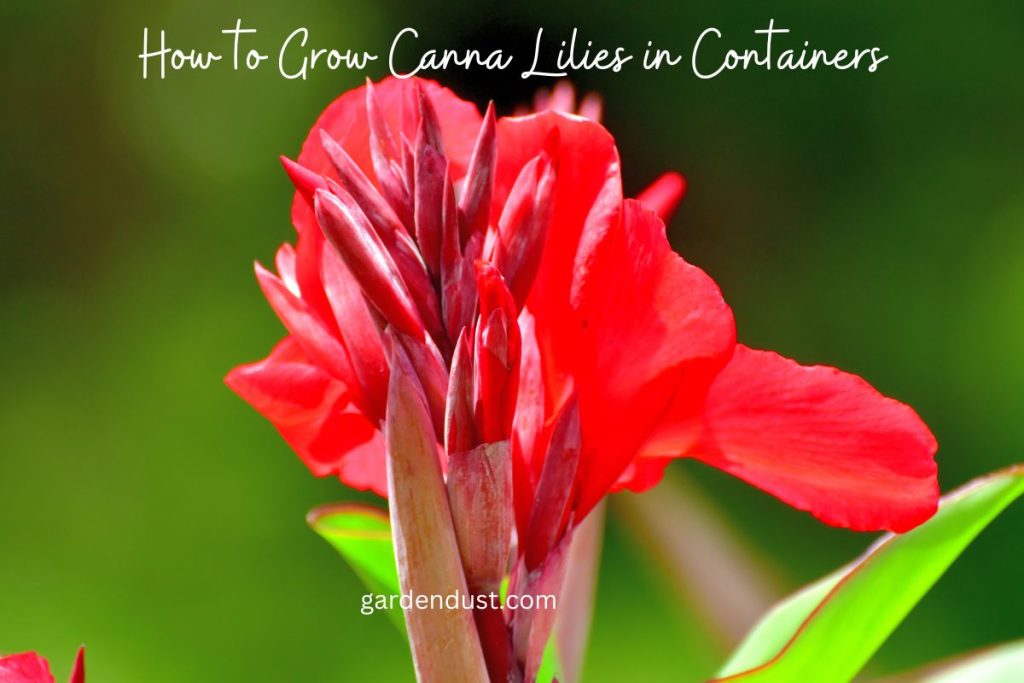Canna lilies, with their vibrant blooms and lush foliage, are a captivating addition to any garden. While traditionally grown in garden beds, these exotic beauties can also thrive in containers, allowing even those with limited space to enjoy their splendor. Growing canna lilies in containers is a rewarding endeavor that brings a touch of tropical elegance to patios, balconies, and small gardens. In this comprehensive guide, we will delve into the step-by-step process of How to Grow Canna Lilies in Containers, from selecting the right container and soil to providing proper care and ensuring a bountiful display of blooms. Let’s start….
Botanical Name-Canna spp.
Genus-Canna
Family-Cannaceae
Native- America
Common Name: Canna Lily
Plant Type– Herbaceous perennial
Plant Size– Height from 1 to 8 feet (30 cm to 2.4 meters)
Flower Colour– Red, orange, yellow, pink, and combinations thereof. The
Foliage-Different shades of green or purple
Blooming Season– late spring to early fall
Usages – Ornamental purposes in gardens and landscapes
Choosing the Right Container
The first step in successfully growing canna lilies in containers is selecting the right container. Canna lilies have robust root systems, so opt for a container that is at least 12 to 18 inches in diameter and 12 to 24 inches deep. Ensure that the container has drainage holes at the bottom to prevent waterlogging, which can lead to root rot.
Consider the material of the container as well. While various materials, such as plastic, ceramic, or terra cotta, can be suitable, it’s essential to choose one that provides insulation against temperature fluctuations. Dark-colored containers can absorb heat, which may impact the roots during hot weather. Select a container that complements the aesthetics of your space while offering functionality for the optimal growth of canna lilies.
Soil Preparation
Canna lilies thrive in well-draining soil with a slightly acidic to neutral pH. A good quality, lightweight potting mix designed for container gardening is ideal. You can enhance the soil’s drainage by adding perlite or coarse sand. Additionally, incorporating organic matter, such as compost, into the soil mix provides essential nutrients for healthy growth.
Fill the container with the prepared potting mix, leaving a few inches at the top for watering. Avoid using garden soil in containers, as it tends to become compacted and hinders proper drainage. Proper soil preparation is crucial for establishing a conducive environment for canna lilies to flourish.
Planting Canna Lily Bulbs
Canna lilies are typically grown from rhizomes, which are thick underground stems. Planting canna lily bulbs in containers is a straightforward process that involves a few key steps:
- Soaking the Rhizomes– Before planting, soak the canna lily rhizomes in water for a few hours. This helps rehydrate the bulbs and jumpstarts the growing process.
- Planting Depth-Plant the rhizomes about 2 to 4 inches deep in the soil, ensuring the eyes (growing points) are facing upward. Space multiple rhizomes at least 12 to 18 inches apart to allow for proper growth.
- Watering-After planting, water the container thoroughly to settle the soil around the rhizomes. Keep the soil consistently moist, but not waterlogged, during the growing season.
Sunlight Requirements
Canna lilies are sun-loving plants that thrive in full to partial sunlight. Choose a location for your container that receives at least 6 to 8 hours of sunlight per day. If you’re growing canna lilies indoors, place the container near a south or west-facing window to ensure they receive an adequate amount of sunlight.
Container-grown canna lilies are adaptable and can tolerate some shade, but they may not produce as many flowers in low-light conditions. Consistent exposure to sunlight is essential for robust growth and vibrant blooms.
Watering Routine
Proper watering is crucial for the health of container-grown canna lilies. These plants prefer consistently moist soil but are susceptible to root rot if overwatered. To strike the right balance:
- Watering Frequency-Water the container when the top inch of the soil feels dry. During hot weather, you may need to water more frequently, possibly every 2-3 days.
- Avoid Waterlogging-Ensure that the container has drainage holes and that excess water can escape. Waterlogged soil can lead to root rot, compromising the health of the canna lilies.
- Mulching-Applying a layer of organic mulch, such as shredded bark or straw, helps retain soil moisture and regulates temperature, contributing to the overall well-being of the plants.
HOW TO GROW AND CARE FOR BITTER GOURD IN CONTAINER
Fertilizer Requirement
Canna lilies are hungry plants that benefit from regular feeding during the growing season. Start by incorporating a balanced, slow-release fertilizer into the potting mix at the time of planting. As the plants begin to grow, supplement with a liquid fertilizer every 2-4 weeks.
During the blooming period, a fertilizer higher in phosphorus can encourage prolific flower production. Follow the recommended dosage on the fertilizer packaging to avoid over-fertilization, which can lead to nutrient imbalances and adversely affect plant health.
Staking for Support
Canna lilies, especially the taller varieties, may require staking to provide support and prevent them from bending or breaking under the weight of their lush foliage and blooms. Use stakes or bamboo poles, placing them in the container at the time of planting to avoid damaging the rhizomes later on. Gently tie the stems to the stakes using soft garden twine, allowing the plants to grow upward while maintaining their structural integrity.
Deadheading and Pruning
To encourage continuous blooming and maintain the aesthetic appeal of your canna lilies, practice deadheading. This involves removing spent flowers by cutting them back to the base of the stem. Deadheading redirects the plant’s energy from seed production to the development of new blooms, ensuring a more extended and vibrant flowering period.
Additionally, pruning canna lilies is beneficial for controlling their size and shape. Trim yellowing or damaged leaves at the base of the plant to promote air circulation and reduce the risk of disease. Regular deadheading and pruning contribute to the overall health and beauty of container-grown canna lilies.
Overwintering Canna Lilies in Containers
In regions where winters are harsh, it’s essential to protect container-grown canna lilies from frost damage. As temperatures drop, consider the following steps for overwintering:
- Trimming Back Foliage: Once the foliage has been affected by the first frost, trim it back to a few inches above the soil line. This prevents the rhizomes from expending unnecessary energy on maintaining above-ground growth.
- Lifting and Storing Rhizomes: In colder climates, consider lifting the rhizomes from the container and storing them indoors for the winter. Allow the rhizomes to dry for a few days, then place them in a cool, dark, and dry location.
- Insulating Containers: If leaving the rhizomes in the container, insulate it with a layer of mulch or straw to protect against freezing temperatures. Move the container to a sheltered location, such as a garage or shed.
Troubleshooting Common Issues
Container gardening offers a degree of control over the growing environment, but challenges may still arise. Be vigilant and address issues promptly to ensure the health and vitality of your canna lilies:
- Pest Management: Keep an eye out for common garden pests, such as aphids or spider mites. Insecticidal soap or neem oil can be effective in controlling these pests without harming the plants.
- Disease Prevention: Adequate spacing, proper watering, and good air circulation help prevent fungal diseases such as leaf spot or rust. If signs of disease appear, treat promptly with fungicides according to the product instructions.
- Nutrient Deficiencies: Monitor your canna lilies for signs of nutrient deficiencies, such as yellowing leaves. Adjust your fertilizing routine accordingly to provide the necessary nutrients for healthy growth.
Growing canna lilies in containers offers a gateway to the allure of these tropical gems, even in limited gardening spaces. By carefully selecting containers, preparing the right soil mix, and providing proper care, you can cultivate a striking display of canna lilies that brings a touch of exotic elegance to your surroundings. Whether adorning a balcony, patio, or small garden, container-grown canna lilies reward gardeners with vibrant blooms, lush foliage, and a sense of accomplishment in mastering the art of cultivating these enchanting plants. Happy Gardening….







